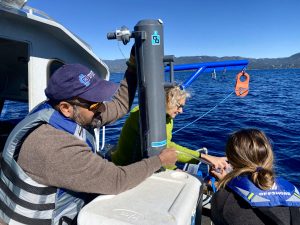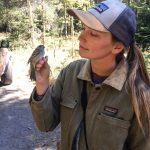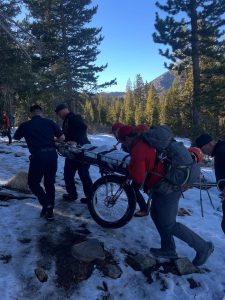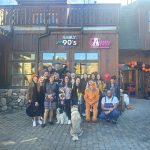How an international collaboration is helping Tahoe get ahead of climate impacts
LAKE TAHOE, Calif. / Nev. – Thanks to an international collaboration with Italian researchers, Lake Tahoe is getting ahead of a looming change expected to strike towards the end of the century.
Based on the shifting climate, precipitation, and wind, scientists, including Sudeep Chandra, PhD, professor and limnologist at the University of Nevada, Reno, expect Lake Tahoe to stop mixing between 2070 and 2100.
Mixing redistributes oxygen and nutrients throughout the water column. The lack of this ritual churning brings a host of implications and new challenges when it comes to lake management.
For Italian lakes like Maggiore and Iseo, this stagnation isn’t new. These lakes stopped mixing around 2006 as milder winters prevented surface water from cooling enough to equalize in density and mix with bottom water.
It’s something Italian researcher Barbara Leoni has followed and studied over the years, now with Veronica Nava.

These Italian lakes, similar in structure to Tahoe, offer a mirror reflecting insights for Tahoe’s future.
“We’re trying to get ahead of this issue that will arise as the climate changes so managers can create progressive policies which manage for a new lake future,” Chandra explained while sampling Tahoe with Leoni and Nava in the middle of October. This collaboration helps them do so.
By the time Tahoe stops mixing, there will be a generation’s worth of research, insights and lessons from the Italian lakes.
Driving science through cultural connectivity
A 2024 agreement siged by UNR President, Brian Sandoval, and his counterpart at the University of Milano-Bicocca formalized the joint research effort between the international scientists and named it Freshwater Innovations in Research and Education, or FIRE for short.
“We want to share knowledge between our countries” Chandra said, “because that’s how we can conserve lakes for future generations.”
The collaboration has nurtured an environment where partners can exchange not only science, but culture as well. Nava has discovered her fondness for Mexican food and Chandra, the superiority of Italy’s gelato and pasta. For Leoni, it’s the immersive experience.
“I like it very much to collaborate with other scientists outside our border,” Leoni said, “because it’s really stimulating.”
Converging on these cultural grounds can ultimately plant seeds for scientific breakthroughs.
“Cultural connectivity is so important in driving the science production,” Chandra said. “I learned the Italian culture is extremely welcoming to share information.”
As Chandra has learned many lessons for Tahoe from Leoni and Nava’s research on Lake Maggiore and Iseo, the Italian researchers have gleaned insights as well.
Nava was not only struck by Tahoe’s beauty, but by the utilization of science among managers and stakeholders on informing regional policy. It’s something her and Leoni hope to spark more of in Italy.
Putting the FLAME in FIRE
FIRE seeks to bring new innovative tools for understanding changes to these lakes. One such tool is known as FLAME, a creation of Luke C. Loken’s that can tell the lake’s complex story in realtime, including its composition of green house gasses (carbon dioxide and methane), oxygen, temperature, conduction, pH, nitrates, turbidity, and others.
“There are many things that are happening and the power of [FLAME] is that you have all these parameters together,” Nava explained, “and you can really get a better understanding of all these processes.”
Affixed to the research boat with components of car batteries, water pumps, pipes, and analyzers—all orchestrated by a black box referred to as the brain—FLAME draws surface water at one end and churns out realtime readings on a computer at the other end.
Guided by captain Katie Senft, the research boat steers over open water, lake edges and into marinas, collecting data at different depths and habitats.
While offering insight in realtime, FLAME also logs a data map of the surface water quality.
Going from the open water and into a marina, for example, reveals a significant reduction in carbon dioxide and a rise in methane levels, likely due to the abundance of plants in marinas, shedding light on their impacts.
“Each marina plays a really important society role by harboring or holding boats for recreation, sometimes allowing our boats to overwinter, but,” Chandra said, “these marinas and the nearshore of Tahoe also harbor invasive plants, invasive species and now, they’re also playing key roles in the carbon cycle.”
Uncovering the role of marinas and other parts of the nearshore environment is a part of their goal, adding to beneficial knowledge when it comes to making water quality decisions.
FIRE is also comparing Tahoe’s surface water quality and gas levels to Lake Maggiore and Iseo. The partnership sampled and mapped these Italian lakes last year.
Another study area focuses on how edges of lakes differ in greenhouse gases compared to open water.
The researchers also want to deepen their understanding of how watershed inflows (creeks and rivers) impact these lakes.
Beyond clarity
FIRE isn’t just taking a surface level look at water quality, partners are diving into monitoring how these parameters change at different depths. While sampling Lake Tahoe in October, Chandra, Leoni, Nava and Senft, took samples at numerous depths.
“In addition to Keeping Tahoe Blue, the mantra of the bumper stickers, we want to understand the drivers of clarity and how the lake is changing at depth” Chandra said, emphasizing that a change in clarity also shifts the ecology of the lake bottom.
With Tahoe losing about one third of its clarity since the late 1960s, it has lost so much more along the lake bottom. Looking at a tree-covered mountain on the west shore, Chandra said while on the boat, “Imagine you’ve just lost one third of the trees.”
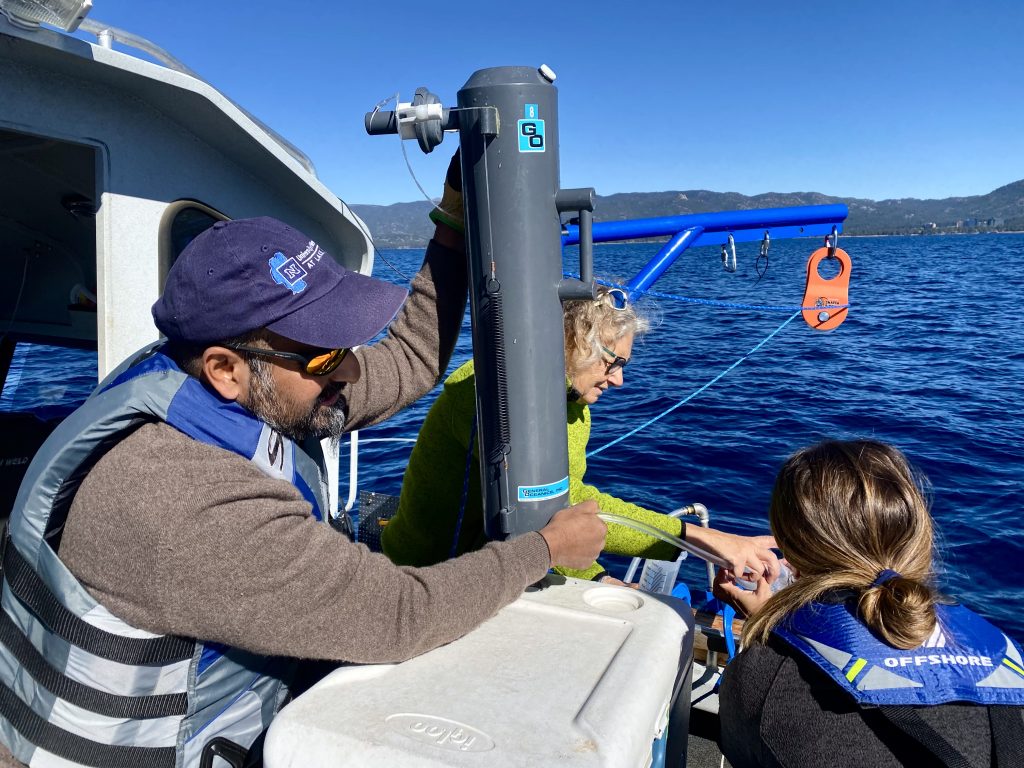
Evaluating the water quality at these different depths will begin to paint the picture of how this habitat loss is impacting the lake.
Dissecting these depths will also help FIRE reveal how snowmelt settles into the lake and what materials it brings with it. The researchers are also testing their samples for isotopic concentrations of methane to deduce the source of greenhouse gasses.
Now that Lake Tahoe, Lake Maggiore and Iseo are sampled and mapped, FIRE’s next steps are interpreting the information to understand these study areas and explain how these lakes operate and the lessons they can share with each other and the managers that want to conserve these lakes for future generations.

Support Local Journalism

Support Local Journalism
Readers around the Lake Tahoe Basin and beyond make the Tahoe Tribune's work possible. Your financial contribution supports our efforts to deliver quality, locally relevant journalism.
Now more than ever, your support is critical to help us keep our community informed about the evolving coronavirus pandemic and the impact it is having locally. Every contribution, however large or small, will make a difference.
Your donation will help us continue to cover COVID-19 and our other vital local news.



